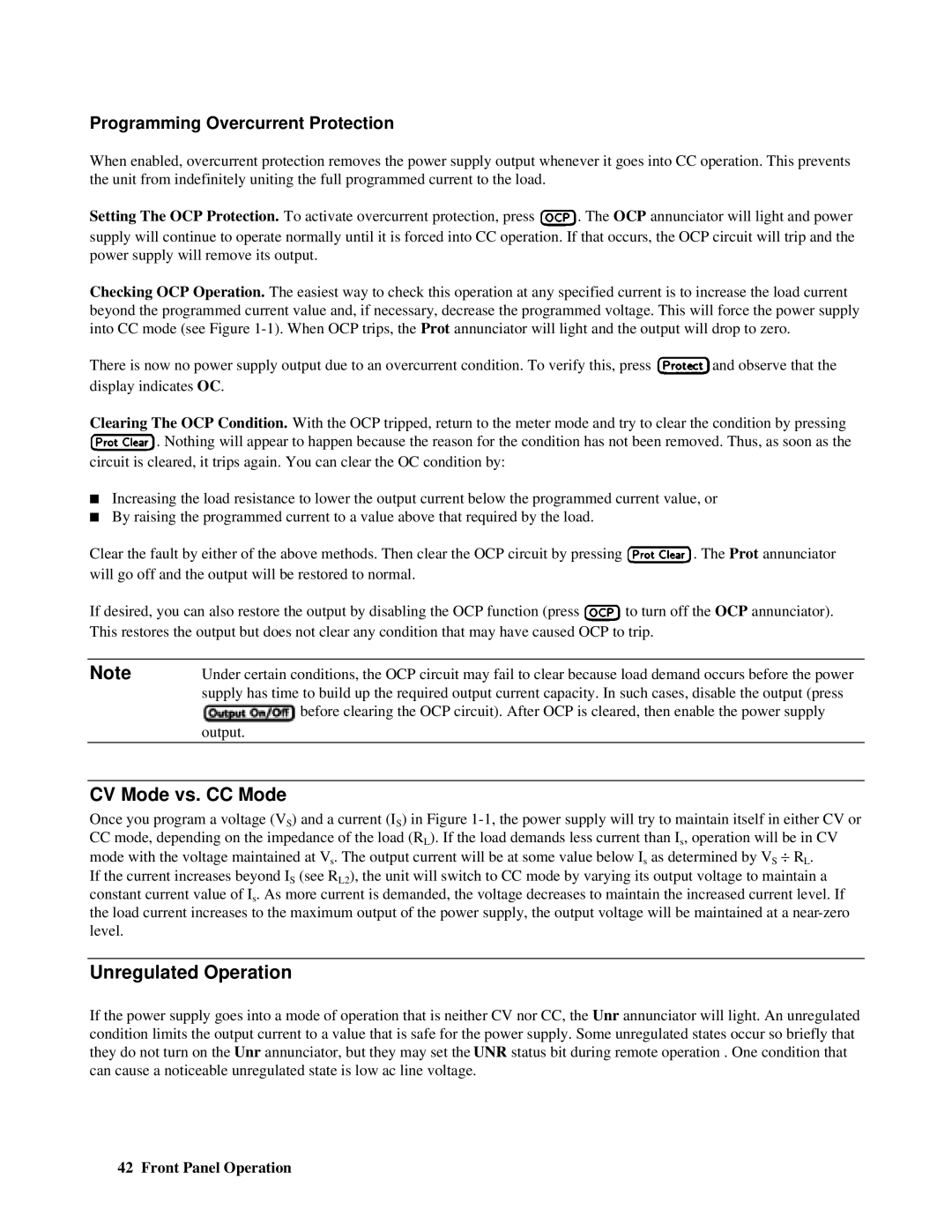
Programming Overcurrent Protection
When enabled, overcurrent protection removes the power supply output whenever it goes into CC operation. This prevents the unit from indefinitely uniting the full programmed current to the load.
Setting The OCP Protection. To activate overcurrent protection, press ![]() . The OCP annunciator will light and power supply will continue to operate normally until it is forced into CC operation. If that occurs, the OCP circuit will trip and the power supply will remove its output.
. The OCP annunciator will light and power supply will continue to operate normally until it is forced into CC operation. If that occurs, the OCP circuit will trip and the power supply will remove its output.
Checking OCP Operation. The easiest way to check this operation at any specified current is to increase the load current beyond the programmed current value and, if necessary, decrease the programmed voltage. This will force the power supply into CC mode (see Figure
There is now no power supply output due to an overcurrent condition. To verify this, press ![]() and observe that the display indicates OC.
and observe that the display indicates OC.
Clearing The OCP Condition. With the OCP tripped, return to the meter mode and try to clear the condition by pressing ![]() . Nothing will appear to happen because the reason for the condition has not been removed. Thus, as soon as the circuit is cleared, it trips again. You can clear the OC condition by:
. Nothing will appear to happen because the reason for the condition has not been removed. Thus, as soon as the circuit is cleared, it trips again. You can clear the OC condition by:
■Increasing the load resistance to lower the output current below the programmed current value, or
■By raising the programmed current to a value above that required by the load.
Clear the fault by either of the above methods. Then clear the OCP circuit by pressing ![]() . The Prot annunciator will go off and the output will be restored to normal.
. The Prot annunciator will go off and the output will be restored to normal.
If desired, you can also restore the output by disabling the OCP function (press ![]() to turn off the OCP annunciator). This restores the output but does not clear any condition that may have caused OCP to trip.
to turn off the OCP annunciator). This restores the output but does not clear any condition that may have caused OCP to trip.
Note | Under certain conditions, the OCP circuit may fail to clear because load demand occurs before the power |
| supply has time to build up the required output current capacity. In such cases, disable the output (press |
| before clearing the OCP circuit). After OCP is cleared, then enable the power supply |
| output. |
|
|
CV Mode vs. CC Mode
Once you program a voltage (VS) and a current (IS) in Figure
CCmode, depending on the impedance of the load (RL). If the load demands less current than Is, operation will be in CV mode with the voltage maintained at Vs. The output current will be at some value below Is as determined by VS ÷ RL.
If the current increases beyond IS (see RL2), the unit will switch to CC mode by varying its output voltage to maintain a constant current value of Is. As more current is demanded, the voltage decreases to maintain the increased current level. If the load current increases to the maximum output of the power supply, the output voltage will be maintained at a
Unregulated Operation
If the power supply goes into a mode of operation that is neither CV nor CC, the Unr annunciator will light. An unregulated condition limits the output current to a value that is safe for the power supply. Some unregulated states occur so briefly that they do not turn on the Unr annunciator, but they may set the UNR status bit during remote operation . One condition that can cause a noticeable unregulated state is low ac line voltage.
